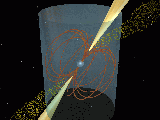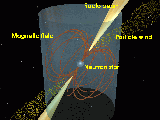Part-time pulsar yields new insight into inner workings of cosmic clocks
3rd March 2006
Astronomers using the 76-m Lovell radio telescope at the University of Manchester's Jodrell Bank Observatory have discovered a very strange pulsar that helps explain how pulsars act as 'cosmic clocks' and confirms theories put forward 37 years ago to explain the way in which pulsars emit their regular beams of radio waves - considered to be one of the hardest problems in astrophysics. Their research, now published in Science Express, reveals a pulsar that is only 'on' for part of the time. The strange pulsar is spinning about its own axis and slows down 50% faster when it is 'on' compared to when it is 'off'.
Pulsars are dense, highly magnetized neutron stars that are born in a violent explosion marking the death of massive stars. They act like cosmic lighthouses as they project a rotating beam of radio waves across the galaxy. Dr. Michael Kramer explains, "Pulsars are a physicist's dream come true. They are made of the most extreme matter that we know of in the Universe, and their highly stable rotation makes them super-precise cosmic clocks. But, embarrassingly, we do not know how these clocks work. This discovery goes a long way towards solving this problem."
The research team, led by Dr. Michael Kramer, found a pulsar that is only periodically active. It appears as a normal pulsar for about a week and then "switches off" for about one month before emitting pulses again. The pulsar, called PSR B1931+24, is unique in this behaviour and affords astronomers an opportunity to compare its quiet and active phases. As it is quiet the majority of the time, it is difficult to detect, suggesting that there may be many other similar objects that have, so far, escaped detection.
Prof. Andrew Lyne points out that, "After the discovery of pulsars, theoreticians proposed that strong electric fields rip particles out of the neutron star surface into a surrounding magnetised cloud of plasma called the magnetosphere. But, for nearly 40 years, there had been no way to test whether our basic understanding was correct."
The University of Manchester astronomers were delighted when they found that this pulsar slows down more rapidly when the pulsar is on than when it is off. Dr. Christine Jordan points out the importance of this discovery, "We can clearly see that something hits the brakes when the pulsar is on."
This breaking mechanism must be related to the radio emission and the processes creating it and the additional slow-down can be explained by a wind of particles leaving the pulsar's magnetosphere and carrying away rotational energy. "Such a braking effect of the pulsar wind was expected but now, finally, we have observational evidence for it" adds Dr Duncan Lorimer.
The amount of braking can be related to the number of charges leaving the pulsar magnetosphere. Dr. Michael Kramer explains their surprise when it was found that the resulting number was within 2% of the theoretical predictions. "We were really shocked when we saw these numbers on our screens. Given the pulsar's complexity, we never really expected the magnetospheric theory to work so well."
Prof. Andrew Lyne summarized the result: "It is amazing that, after almost 40 years, we have not only found a new, unusual, pulsar phenomenon but also a very unexpected way to confirm some fundamental theories about the nature of pulsars."
Images - Click for full size images
The current understanding of a pulsar. The central neutron star is highly magnetised and emits a radio beam along its magnetic axis, which is inclined to the rotation axis. The strong magnetic field eventually leads to the extraction of particles from the surface, filling the surrounding, so-called magnetosphere with plasma. The size of the magnetosphere is given by the distance where plasma co-rotation reaches the speed of light, the so-called light-cylinder. The plasma creating the radio emission eventually leaves the light cylinder as a pulsar wind, which provides a torque onto the pulsar, contributing about 50% to its observed slow-down in rotation. Credit: Michael Kramer
Un-labelled version of the above figure. Also available as a Hi-res image. Credit: Michael Kramer
When the radio emission stops, the pulsar wind also vanishes, and the slow-down of the pulsar is dominated by its magnetic field. Credit: Michael Kramer
Animation

Available as .avi format (3.2MB) or .mpg format (1.1MB)
The pulsar switches on and off in a periodic fashion. Shown here in a very time-compressed version not to scale, the pulsar is on for about a week before shutting off for about a month. When the pulsar is on, the radio beam sweeps the sky, and a particle winds slows down the pulsar 50% more than during times when the pulsar is off. Credit: Michael Kramer
Contacts
Dr Michael Kramer,
University of Manchester
+44 1477 571321
mkramer@jb.man.ac.uk
Professor Andrew Lyne,
University of Manchester
+44 1477 571321
agl@jb.man.ac.uk
Julia Maddock
PPARC Press Office
Tel +44 1793 442094
Email: julia.maddock@pparc.ac.uk
Publication
"A Periodically Active Pulsar Giving Insight into Magnetospheric Physics"
M.Kramer, A.G.Lyne, J.T.O'Brien, C.A.Jordan and D.R. Lorimer
To be published in the journal Science.
Click to download the abstract or full reprint of the paper.
Background Information
A pulsar is a neutron star, which is the collapsed core of a massive star that has ended its life in a supernova explosion. Weighing more than our Sun, yet only 20 kilometres across, these incredibly dense objects produce a beam of radio waves which sweeps around the sky like a lighthouse, often hundreds of times a second. Radio telescopes receive a regular train of pulses as the beam repeatedly crosses the Earth so the object is observed as a pulsating radio signal.
The unique activity of the pulsar PSR B1931+24 was discovered during routine timing measurments carried out by the University of Manchester's 76m Lovell Telescope. It became clear a few years ago that the pulsar was not detected in many of the regular observations and the pulsar appeared to be bimodal, the pulsar being either ON or OFF in a quasi-periodic fashion. Studying the data ammased from 1998 to 2005 showed that the periodicity varied between 30 to 40 days. No other known pulsar behaves in this way.
The Jodrell Bank work was supported by funding from the UK Particle Physics and Astronomy Research Council (PPARC). Jodrell Bank Observatory is part of the School of Physics and Astronomy at The University of Manchester. The Observatory is home to the Lovell Radio Telescope and the MERLIN/VLBI National Facility which is operated by the University on behalf of PPARC.
Further information on pulsars can be found on the Jodrell Bank Observatory Pulsar Group pages.
The Particle Physics and Astronomy Research Council (PPARC) is the UK's strategic science investment agency. It funds research, education and public understanding in four areas of science - particle physics, astronomy, cosmology and space science.
PPARC is government funded and provides research grants and studentships to scientists in British universities, gives researchers access to world-class facilities and funds the UK membership of international bodies such as the European Laboratory for Particle Physics (CERN), and the European Space Agency. It also contributes money for the UK telescopes overseas on La Palma, Hawaii, Australia and in Chile, the UK Astronomy Technology Centre at the Royal Observatory, Edinburgh and the MERLIN/VLBI National Facility, which includes the Lovell Telescope at Jodrell Bank observatory.
PPARC's Public Understanding of Science and Technology Awards Scheme funds both small local projects and national initiatives aimed at improving public understanding of its areas of science.




